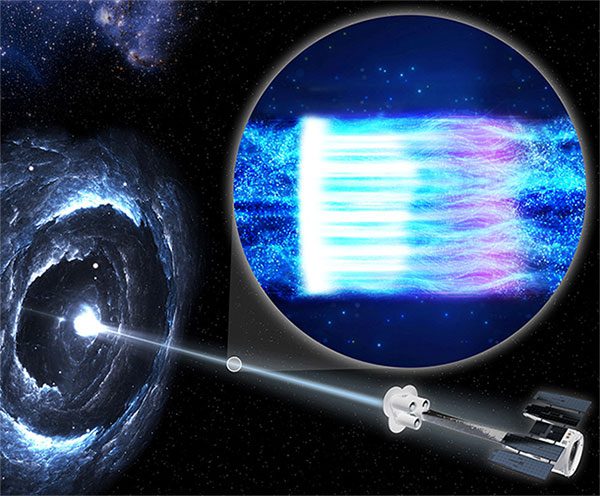On November 23, researchers unveiled the mystery of colossal black holes that devour surrounding matter and release enormous, luminous energy particles into space.
Utilizing data from the Imaging X-ray Polarimetry Explorer (IXPE), recently deployed, researchers provided a explanation for the existence of black holes.

The Imaging X-ray Polarimetry Explorer (IXPE) measures rays from the galaxy Markarian 501 – (Photo: REUTERS).
Most galaxies are formed around supermassive black holes. While many black holes are relatively benign, like the one at the center of the Milky Way, some are highly aggressive, consuming surrounding matter and releasing enormous, brilliant energy particles into space.
According to Reuters, researchers explained that the glowing rays are produced by shockwaves traveling at supersonic speeds away from the black hole, energizing subatomic particles known as electrons.
They studied a peculiar object known as a “blazar” at the center of Markarian 501, a large elliptical galaxy located about 460 million light-years from Earth in the direction of the constellation Hercules.
A blazar consists of a supermassive black hole that can consume a disk of gas and dust, emitting jets of matter at the speed of light. When these jets are directed straight towards Earth, the object is classified as a blazar.
“Blazars are the brightest, most persistent objects in our universe. They possess the highest energy. They have the largest, most fearsome black holes. Everything happening around them is incredibly fascinating,” said astronomer Yannis Liodakis from the Finnish Center for Astronomy, the lead author of the study.
Scientists have long investigated how the rays emitted from blazars can shine over distances of about a million light-years.
Alan Marscher, an astrophysicist and co-author of the study from Boston University, stated: “The light we see originates from rays coming from electrons. The type of rays we observe in Markarian 501 can only be emitted by extremely high-energy electrons.”
The driving force behind this phenomenon is a black hole, an extremely dense object with a gravitational pull so strong that not even light can escape.
The supermassive black hole at the center of Markarian 501 has a mass approximately one billion times that of our Sun and is about 200 times more massive than Sagittarius A*, the supermassive black hole in the Milky Way.


















































